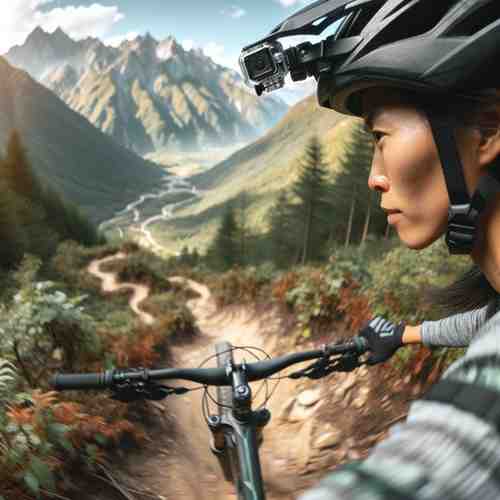In a time where recording every second of every day has become routine, headcams have become a cutting-edge tool to record experiences without hands. From extreme sports fans to professional professionals from various fields, headcams provide a distinct viewpoint that conventional cameras cannot match. This article explores the realm of headcams and their meaning, applications, technology, advantages, and potential disadvantages.

Contents
What is a Headcam?
A headcam, also known as a head-mounted camera, is a small, light camera designed to be worn on the head. It is typically connected via the head strap, a helmet mount, or any other type of headgear. The camera’s shrewd placement allows users to record footage from the perspective of a person in the first person, creating an immersive experience for the viewer.
Uses of Headcams
They are highly versatile and have applications across a variety of fields:
Sports and Adventure
Adventurers and athletes use cameras to record activities like skiing, skydiving, mountain biking, and scuba diving. First-person video footage gives thrilling views of the excitement.
Professional utilization
In professions such as police, firefighting, and surgical procedures, as well as headcams, are utilized for training and documenting and to improve situational awareness. Headcams allow recording crucial procedures and operations that can be later examined for legal or training reasons.
Content creation
Vloggers and other content creators use headcams to create captivating and engaging videos. It doesn’t matter if it’s a travel-themed vlog or a daily-life-style video headcam that offers a unique viewpoint that is a hit with viewers.
In research and education settings
headcams are used to make instructional videos, conduct studies, or even record them. Headcams provide a hands-free method to record and communicate detailed results and processes.
Extreme Sports Documentation:
Capture exciting first-person videos of sports like skiing, mountain biking, and skydiving, providing an unforgettable experience for the viewers.
Law Enforcement
Headcams used by police officers capture incidents and interactions, which can be used as evidence, increasing accountability.
Surgical Procedures: Surgeons use headcams to record procedures, and they can be utilized for education and thorough post-operation reviews.
Firefighting
Headcams assist firefighters in assessing situations live and then review the footage in the future for training or investigation for investigation and training purposes.
Travel Vlogging
Travel bloggers use their headcams to produce engaging content by capturing their travels from a first-person viewpoint.
Wildlife Research
Researchers and biologists use headcams to record and observe the behavior of animals in their natural environments without disturbing them.
Sports Coaching
Coaches use headcams to evaluate the performance of athletes, assisting in identifying areas of improvement and improving training techniques.
Construction Site Monitoring
Headcams are utilized on construction sites to record work progress, ensure safety compliance, and provide visual records to manage projects.
Educational Tutorials
Headcams are used by educators and teachers for instructional videos, giving students hands-on views of demonstrations and experiments.
Underwater Exploration
Divers utilize waterproof headcams to record underwater activities, ranging from research on marine life to dive adventures.
Live Streaming Events
Headcams allow live streaming of events and provide viewers with the most immersive first-person perspective of sporting events, concerts, and other live events.
Search and Rescue Operations
The rescue teams utilize headcams to track and record rugged terrains, improving coordination and communication during missions.
Cycling and Running
Runners and cyclists wear headcams to track their runs, track their progress in training, and share their experiences with others.
Home Improvement Projects
DIYers use their headcams to capture their work, allowing users to look back at their work and discuss tips and tricks with others.
Gaming and VR Content
Creators of VR and gaming make use of headcams to create video games that are immersive and immersive, as well as virtual real-world experiences that provide unique and entertaining video content.
Technological Advancements
Headcams have experienced significant technological advances over the decades:
- HD Video Headcams of today provide 4K video resolution and crystal clear video.
- Stabilization of images using advanced technology allows for smooth, free-of-shake videos even in situations with high action levels.
- Waterproofing Headcams have been made to be waterproof, which makes them ideal for water sports.
- The Life of the Battery The latest battery technology guarantees that headcams can record over long periods, which is essential for extended adventures and professional usage.
- Connectivity, built-in Wi-Fi, and Bluetooth allow easy video sharing and live streaming. Specific models also support GPS tracking and data overlay to provide additional context.
Benefits of Using Headcams
- Hands-Free Operation The main benefit of a headcam is the hands-free operation that allows users to concentrate on their tasks and not worry about handling a camera.
- Immersive experience footage captured by head cameras gives you an immersive view from a first-person point of view that conventional cameras can’t replicate.
- Flexibility Headcams can be adapted to various activities and settings, including extreme sports and professional environments.
- Durability: Built to stand up to the elements, headcams are constructed robustly, which makes them perfect for use in harsh environments.
Potential Drawbacks
Although headcams have many advantages, there are also some disadvantages that you should consider.
- Comfort Headcams worn for long periods can be uncomfortable, mainly if the headcam is heavy or bulky.
- The Life of the Battery Although improvements have been made, battery life is still an issue, especially in harsh environments, where batteries are more likely to deplete faster.
- A fixed field of view might not capture all aspects, particularly in dynamic situations where the subject changes.
- Privacy Issues The capability to keep records discreetly can cause privacy concerns, especially in public and sensitive spaces.
Conclusion
Headcams have revolutionized how we record and share our experiences and offer a distinct blend of ease of use, flexibility, and stunning footage. If you’re an adventurer professional, creator of content, or teacher, a headcam is a valuable tool. As technology advances, we’ll see new and innovative applications for these amazing devices.